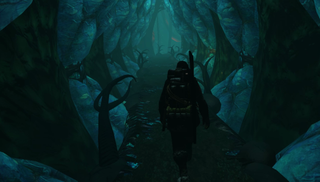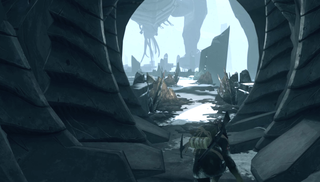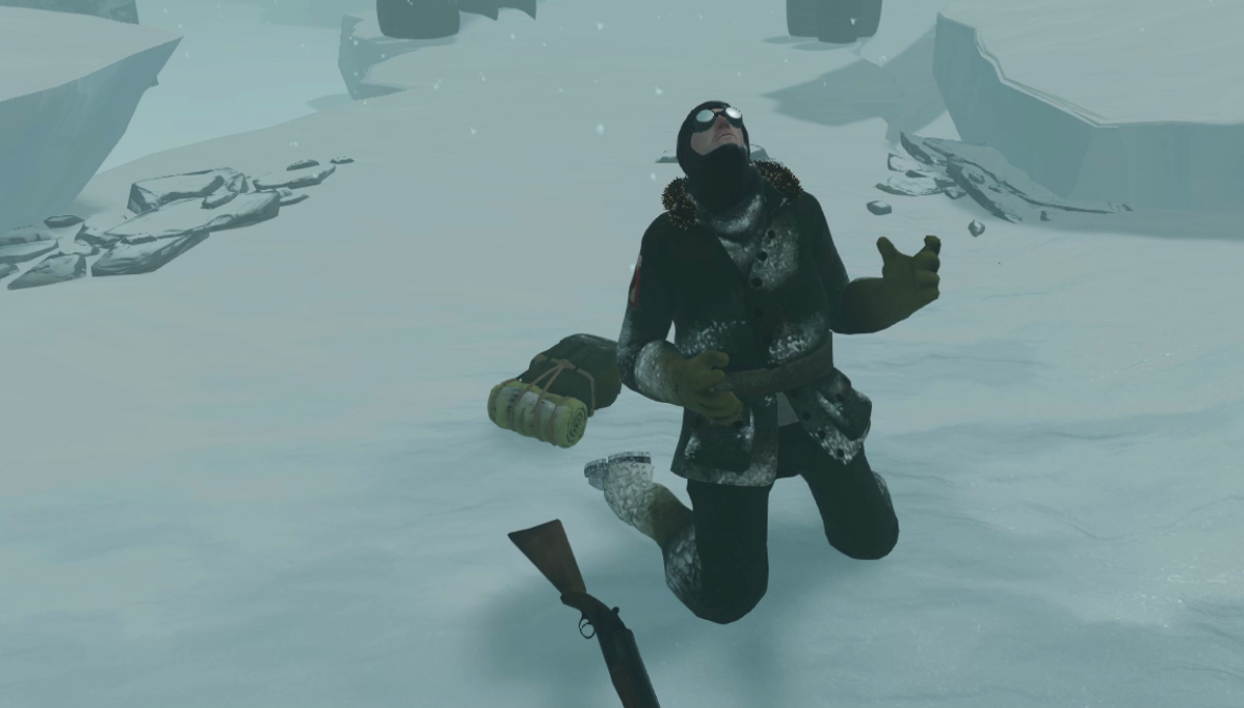Our Verdict
VR can’t elevate Edge of Nowhere’s mediocre climbing, shallow combat, and contrived story.
PC Gamer's got your back
What is it? A third-person Lovecraftian action game.
Expect to pay: $40
Developer: Insomniac Games
Publisher: Oculus
Reviewed on: Oculus Rift (required), Intel Core i7-4770K, GTX Titan Black
Link: Official site
There’s a dark cave early on in Edge of Nowhere, Insomniac’s third-person action adventure for the Oculus Rift, that made me question my sense of reality. Indiscernible screeches and whispers sound off in my periphery and I snap my head to the direction of each in twitchy instinct. During those brief seconds of head motion, small figures and shapes flash directly in front of my eyes. The darkness dissolves and the facade of a house appears on the far cave wall. My hackles rise and I get a little queasy, but not due to motion sickness.
Without VR, the scene wouldn’t have the same impact. Instead of naturally reacting to the slow dissolution of my perceived reality, I’d be staring at a 2D plane, maybe excited and intrigued by the creepy light display, but not truly unnerved. It’s the only effective scene of the entire game, though. Edge of Nowhere quickly abandons chasing surreal experiments in VR in favor of familiarity: climbing ice walls, throwing rocks to distract dull monsters, and telling a routine Lovecraftian story—the result is a mundane action platformer compromised, not enhanced, by VR.
Closer to the edge
Edge of Nowhere places you in the role of Victor Howard, a man in search of his fiancee, Ava Thorne, who went missing on a research expedition in Antarctica. If the plot sounds familiar, then don't expect to be surprised. Forbidden knowledge, supernatural cases of impostor syndrome, and tentacles all come into play. This is a hybrid Lovecraft adventure that pulls from every arctic mishap under the midnight sun, and in doing so, fails to establish any intrigue or identity of its own. Journals strewn about the environments dole out story in cliched strokes, recounting unimaginable horrors and hinting at the protagonist’s questionable sanity. Surreal interludes play with the nature of reality, turning twisting underground arctic tunnels into narrative funhouses where Howard recounts his backstory in a welcome variety of backdrops—an old university lecture hall, the Chilean jungle, and so on. But soon the scene dissipates and it’s back to hoofing up winding ice walls and holding up on the joystick through monotonous Antarctic caverns.
The climbing is limited and frustrating. When I slowly ascend an ice wall and prepare to leap from it to a nearby ledge, I doubt myself less than I do the platforming mechanics. Sometimes my character leaps way too far and I miss an ice wall entirely, which means repeating the climbing section up until that point. Navigating long stretches of ice walls doesn’t call for much interaction beyond moving the stick around and jumping on occasion. In Tomb Raider or The Climb, another Rift game, I have to at least spot my line up and around craggy cliffsides—they build an illusion of improvisation. In Edge of Nowhere, I just follow the wide, boring blue path to its inevitable conclusion, which is still easy to mess up.
I just follow the wide, boring blue path to its inevitable conclusion, which is still easy to mess up.
The climbing sequences are clearly outlined by a flat ice texture, a lumpy blue that isn’t much to look at in VR. The camera positions itself as precariously as possible—high angles that remind you where the ground is, somewhere in the mist below. On occasion it’ll bring some icicles into the foreground, but it didn’t take long for an icicle two inches from my face to become as routine as a tentacled manbeast snapping my neck. There’s really not much to gain from Edge of Nowhere in VR—I hardly ever wanted to inspect the environment, the creatures, or quieter set pieces. Using your sightline to point the headlamp is cool, but to accommodate for sitting down in VR and to avoid the motion sickness traditional free camera controls can induce, all of the action is funneled down a very narrow path. It’s even more linear than the linear games of its ilk, which would be fine if there were variety in Edge of Nowhere’s environments, but it depends far too much on its primary palettes: ice and goo.
And ice about to break
Between ice walls and story scenes, Edge of Nowhere pits you against an ancient race of creatures in small stealth arenas. There are a few ways to deal with enemies: sneaking by is a slow, viable method. You can or throw rocks at static spiky plants to attract patrolling monsters toward them and then throw another rock to excite the spikes and impale the curious. I just mowed them down with my shotgun for the most part. Combat scenarios are tense at first—your tools are limited, arenas are tight, and most enemies can suck your face off without issue—but once you have it all figured out, they’re a cinch to deal with.
Enemy senses are made obvious through ‘vision’ cone textures displayed on the floor beneath them, and sounds you make—shooting and swinging your pickaxe—cause a similar bubble of noise. Getting spotted either means spending all your shotgun ammo or dying, waiting for openings in enemy patrols, and going through the same motions again. Rocks and ammo are handed out generously enough, so I abandoned stealth almost entirely in favor of gathering enemies around a spiky bulb for a group impalement or opting for a shotgun shower. It rendered the arena layouts of chest-high walls meant for hiding meaningless, but I enjoyed the shooting anyway.

Holding a trigger lets you aim by looking with the headset, and it feels as snappy and accurate as mouse-aim. The shotgun is loud and powerful, like it’ll fly out of Howard’s arms with every shot. Problem is, because of the constricted tunnel design a sitting VR game requires, almost all of the action happens in front of you. There’s no need to worry about threats from behind. As a result, the combat is just a tension-free matter of attrition: always inching forward, avoiding (or dissolving) enemies in repetitive, constricted patterns, broken up by long stretches of climbing the same blue ice walls.
In VR, where the priority is preserving the illusion, Edge of Nowhere shatters it often.
This isn’t to say Edge of Nowhere is without exciting moments. One large monster is quite the spectacle in VR, and before I acclimated to jumping around, the more dangerous leaps hit my gut with the same impact as waking suddenly from a falling dream. Naturally, the effect lost strength after repeating the same set piece sequences over and over due to getting caught on an invisible piece of the environment or misreading the crumbling walkway below and jumping at the incorrect ledge. In VR, where the priority is preserving the illusion, Edge of Nowhere shatters it often.

The unoriginal narrative concept is driven by mediocre platforming, shallow stealth and combat, and wholly constricted by the narrow (literally) requirements to get an action adventure working in VR. It’s intriguing as an attempt to fit a traditional game genre into an emerging medium, but because Edge of Nowhere doesn’t nail the fundamentals of its climbing and combat, it’s not a great signal light to seek out in the early days of VR. There’s fun to be had in the occasional spectacle, just be sure to fortify your patience ahead of time.
VR can’t elevate Edge of Nowhere’s mediocre climbing, shallow combat, and contrived story.
James is stuck in an endless loop, playing the Dark Souls games on repeat until Elden Ring and Silksong set him free. He's a truffle pig for indie horror and weird FPS games too, seeking out games that actively hurt to play. Otherwise he's wandering Austin, identifying mushrooms and doodling grackles.

Watching an all-romances speedrun of the legendarily janky Fallout: New Vegas is a delight

Activision will send you alarmingly detailed data for every single Call of Duty match you've played in the last 4 years if you ask, and players are using it to figure out their mysterious SBMM rankings

Here's a game about being a depressed, lonely maintenance robot on a long-haul space colony ship
